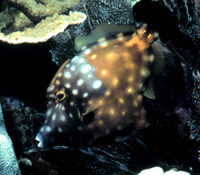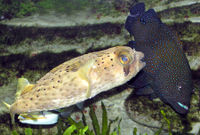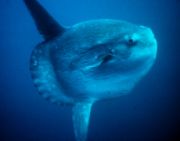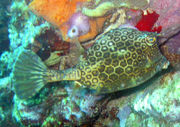| Tetraodontiformes |

American whitespotted filefish,
Cantherhines macrocerus
|
|
Scientific classification |
|
|
| Families |
|
See text. |
The Tetraodontiformes are an
order of highly derived
ray-finned fish, also called the Plectognathi.
Sometimes these are classified as a
suborder of the
Perciformes. The Tetraodontiformes are represented by
ten families and approximately 360 species overall; most are
marine and dwell in and around tropical coral reefs, but a
handful of species are found in freshwater streams and
estuaries. They have no close relatives, and descend
from a line of
coral-dwelling species that emerged around 40 million
years ago.
Physical characteristics
Various bizarre forms are included here, all radical
departures from the streamlined body plan typical of most
fishes. These forms range from nearly square or triangular (boxfishes),
globose (pufferfishes) to laterally compressed (filefishes).
They are ostraciiforms, meaning the body is inflexible, and
undulation during movement is limited to the caudal fin.
Because of this, they are slow-moving and rely on their
pectoral and caudal fins for propulsion. However, movement
is usually quite precise; dorsal and anal fins aid in
manoeuvring and stabilizing. In most species, all fins are
simple, small, and rounded.
The tetraodontiform strategy seems to be defense at the
expense of speed, with all species fortified with scales
modified into strong plates or spines — the latter sometimes
retractable and able to lock in place (the triggerfishes) —
or with tough, leathery skin (the filefishes and ocean
sunfish). Another striking defensive attribute found in the
pufferfishes and porcupinefishes is the ability to inflate
the body to greatly increase its normal diameter: this is
accomplished by sucking water into a diverticulum of the
stomach. Many species of the Tetraodontidae, Triodontidae
and Diodontidae are further protected from predation by
tetraodotoxin, a powerful neurotoxin concentrated in the animals' internal organs.

Long-spine porcupinefish, Diodon holocanthus. On
the right is a blue-spotted grouper, Cephalopholis argus.
Tetraodontiforms have highly modified skeletons, with no
nasal, parietal, infraorbital, or (usually) lower rib bones.
The bones of the jaw are modified and fused into a sort of
"beak"; there are visible sutures which divide the beaks
into "teeth". This is alluded to in their name, derived from
the Greek words tetra meaning "four" and odous meaning
"tooth" and the Latin forma meaning "shape". Counting these
teeth-like bones is a way of distinguishing similar
families. For example the Tetraodontidae ("four-toothed"),
Triodontidae ("three-toothed"), and Diodontidae
("two-toothed").
The jaws are aided by powerful muscles and many species
also have
pharyngeal teeth to further process prey items. This is
because Tetraodontiformes prey mostly on hard-shelled
invertebrates such as crustaceans and shellfish.
The
Molidae are conspicuous even within this oddball order: they
lack swim bladders and spines, and are propelled by their
very tall dorsal and anal fins. The caudal peduncle is
absent and the caudal fin is reduced to a stiff rudder-like
structure. Molids are pelagic rather than reef-associated
and feed on soft-bodied invertebrates, especially jellyfish.
Families

Ocean sunfish.

The
Honeycomb cowfish is part of the Ostraciidae
family.
- Aracanidae
Balistidae — triggerfishes
Diodontidae — porcupinefishes
Molidae — ocean sunfish and relatives
Monacanthidae — filefishes
Ostraciidae — boxfishes
Tetraodontidae — pufferfishes
Triacanthidae — triplespines
Triacanthodidae — spikefishes
Triodontidae — three-toothed puffer
References
-
"Tetraodontiformes".
FishBase. Ed. Ranier Froese and Daniel Pauly.
January 2006 version. N.p.: FishBase, 2006.




